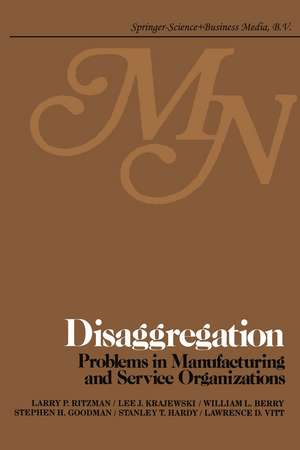Disaggregation: Problems in manufacturing and service organizations
Editat de L.P. Ritzman, M. Tvrdýen Limba Engleză Paperback – 30 dec 2012
Preț: 659.70 lei
Preț vechi: 776.13 lei
-15% Nou
Puncte Express: 990
Preț estimativ în valută:
126.23€ • 131.80$ • 104.47£
126.23€ • 131.80$ • 104.47£
Carte tipărită la comandă
Livrare economică 05-19 aprilie
Preluare comenzi: 021 569.72.76
Specificații
ISBN-13: 9789401576383
ISBN-10: 9401576386
Pagini: 724
Ilustrații: XIX, 703 p. 1 illus.
Dimensiuni: 152 x 229 x 38 mm
Greutate: 0.95 kg
Ediția:Softcover reprint of the original 1st ed. 1979
Editura: SPRINGER NETHERLANDS
Colecția Springer
Locul publicării:Dordrecht, Netherlands
ISBN-10: 9401576386
Pagini: 724
Ilustrații: XIX, 703 p. 1 illus.
Dimensiuni: 152 x 229 x 38 mm
Greutate: 0.95 kg
Ediția:Softcover reprint of the original 1st ed. 1979
Editura: SPRINGER NETHERLANDS
Colecția Springer
Locul publicării:Dordrecht, Netherlands
Public țintă
ResearchCuprins
1. Perspectives on disaggregation.- 2. Disaggregation in manufacturing and service organizations: survey of problems and research.- 3. Toward a theory of hierarchical coordination and conflict.- 4. An MSA view of disaggregation.- 5. Hierarchical planning systems: a production application.- 6. Optimal aggregation and disaggregation in hierarchical planning.- 7. A hierarchical approach for the planning of a complex production system.- 8. A hierarchical approach to multilocation inventory systems.- 9. A disaggregation problem and a search enumeration algorithm for a multiplant, multiproduct scheduling application.- 10. An efficient algorithm for multi-item scheduling.- 11. Large scale optimization for master production scheduling.- 12. Multi-item scheduling with reflection programming.- 13. An approach to the analysis of integrated production-distribution systems.- 14. Empirical relationships among budgets, other financially-oriented aggregate plans, and the master production schedule (MPS).- 15. Hedging the master schedule.- 16. The disaggregation problem in the paper industry.- 17. An economic lot size algorithm for multi-level inventory systems with acyclic network structures.- 18. Impact of a product structure measure on the effectiveness of lot sizing techniques.- 19. The effects of joint lot size strategies on capacity related performance in a multi-stage production-inventory system.- 20. The impact of capacity on lot sizing decisions.- 21. Variations in optimizing serial multi-stage production/inventory systems.- 22. Priority updating procedures in dynamic job shop simulation studies: the impact on measures of performance under different due date assignment rules.- 23. A review of flowshop scheduling research.- 24. An aggregate-disaggregate approach to the large scale multiple project scheduling problem.- 25. Shift scheduling for telephone operators and service office employees.- 26. A complete control system for workforce management at a post office.- 27. Decision making in the public sector: an application of goal interval programming for disaggregation in the post office.- 28. Disaggregation of manpower in a service organization.- 29. Facilities planning in the railroad industry: the need for disaggregation.- 30. Vehicle dispatching — sweep algorithm and extensions.- 31. Navy enlisted manpower planning.- 32. A public policy optimization model with simulation of disaggregation aspects: formulation of energy R and D policy.- 33. Costs and benefits of a computer based regional blood inventory system.- 34. Multi-level police patrol planning.- 35. Disaggregation of the decisions to allocate patrol resources to police precincts.- 36. Economically optimal quantity and mix of fire department services.- 37. Disaggregation planning, scheduling and allocation of nursing staff.- 38. ‘Disaggregate mathematical models of optimal hospital bed management.- 39. Recursive modeling of outpatient health care settings.- 40. Nurse scheduling: a case of disaggregation in the public sector.- 41. Computerized scheduling of hospital nursing personnel: disaggregation to accommodate individual preferences and nonroutine constraints.- 42. Disaggregating health utilization data for planning.- 43. Scheduling workers in situations having highly variable manpower requirements.- 44. Optimal scheduling of two consecutive work periods.- 45. A simple method for obtaining cyclic employee schedules.- 46. Heuristic work force scheduling with variable shift lengths and labor productivity differences: a case study of encoder staffing.










